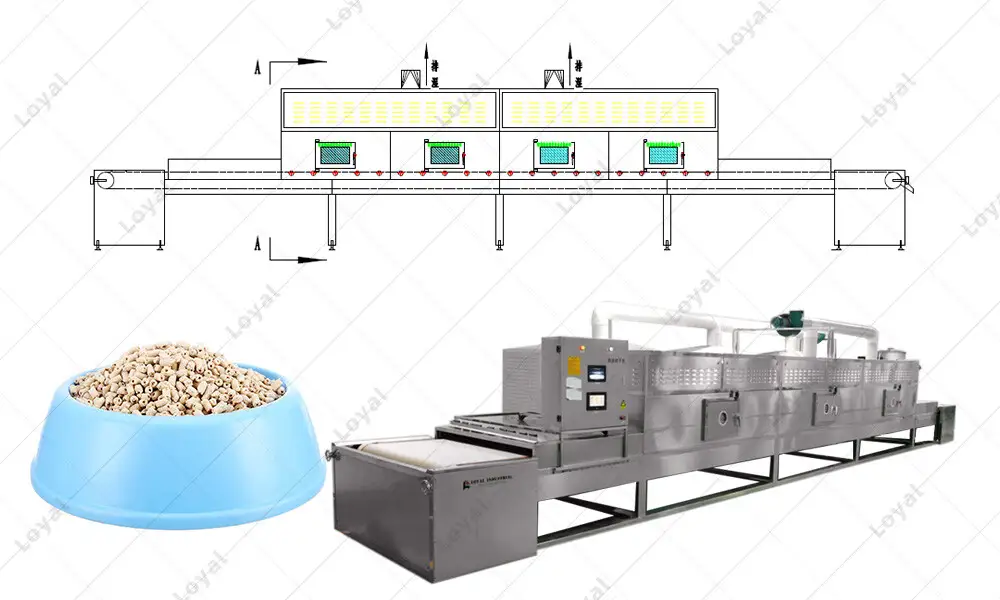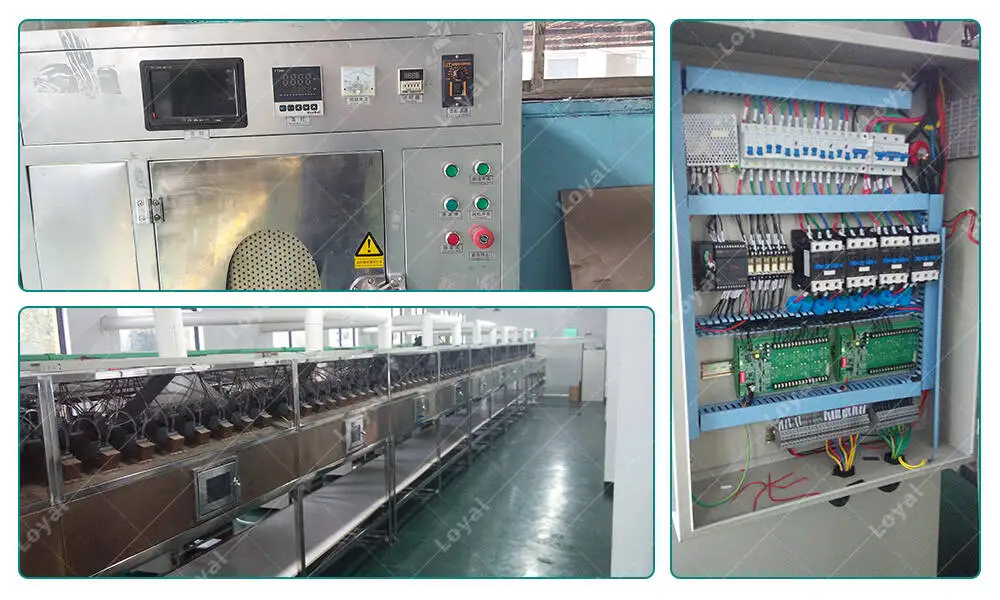Cat Litter Drying Microwave Oven
Description Of Cat Litter Drying Oven
The cat litter drying oven is a machine specially designed to dry cat litter produced using the wet extrusion process. Wet extrusion involves mixing clay or other material with water and extruding it into a litter shape. After the cat litter is extruded, it needs to be dried before it can be packaged and sold. The cat litter drying oven uses hot air to dry cat litter quickly and efficiently. The oven consists of a chamber with a conveyor belt that moves the litter through the oven. Inside, there are heating elements and fans that circulate hot air to dry the litter. Temperature and humidity levels can be adjusted to ensure the litter is properly dried. After the cat litter is dried, it is packaged and sold after cooling. A cat litter dryer is an important piece of equipment for a cat litter manufacturer, as it ensures that the litter is properly dried and ready for sale.

How To Dry The Cat Litter
1.Put the wet cat litter on the conveyor belt of the oven. Make sure the litter is evenly distributed on the conveyor belt surface.
2.Set the temperature of the drying box to a level suitable for drying cat litter. This will depend on the type of litter being dried and the manufacturer's recommended drying conditions.
3.Turn on the fan inside the drying box to circulate hot air over the wet litter. This will help dry the litter quickly and evenly.
4.Monitor the litter as it passes through the drying oven. If necessary, adjust the temperature and humidity levels to ensure the litter dries properly.
5.After the cat litter is dry, cool it down before packing it for sale.
6.Remove litter from conveyor belt and pack according to manufacturer's instructions.
NOTE: Always follow the manufacturer's guidelines when using a litter dryer. Make sure to take proper safety precautions, such as wearing protective clothing and using proper ventilation.

Working Principle Of Industrial Microwave Cat Litter Drying Oven
The industrial microwave cat litter drying oven uses microwave energy to heat and dry cat litter. Microwaves are electromagnetic radiation with high frequencies and short wavelengths. They can pass through materials such as glass, plastic, and ceramics, but are reflected by metals. In the industrial microwave cat litter drying oven, microwave energy is generated by a magnetron, which converts electrical energy into microwaves. These microwaves are then directed into a chamber containing wet litter. When microwaves pass through the litter, they are absorbed by the water molecules in it. This causes the water molecules to vibrate rapidly, which creates heat and causes the water in the litter to evaporate. Microwave energy enters the drying chamber through the waveguide, where it is evenly distributed over the surface of the litter. This ensures that the litter dries evenly and that no parts overheat. Microwave drying is a fast and efficient method of drying cat litter, reducing drying time and saving energy compared to traditional drying methods. However, it's important to make sure the litter doesn't overheat, which can cause it to break down or fail. Therefore, the temperature and duration of the drying process should be carefully controlled.
Microwave Cat Litter Dryer's Advantage
Faster Drying Time | Microwaves can quickly and efficiently evaporate moisture from cat litter, reducing drying time compared to traditional drying methods. |
Energy Saving | Microwave drying requires less energy than other drying methods because it only heats the water molecules present in the litter. |
Increased Production | Faster drying times and energy efficiency can increase productivity and reduce operating costs. |
Uniform Drying | Microwaves are evenly distributed on the surface of the cat litter to ensure uniform drying. |
Improves Litter Quality | By controlling the drying process, microwave drying ensures that litter retains its effectiveness and does not break down or clump together. |
Reduces Odor | By removing moisture from the litter, microwave drying helps reduce the unpleasant odors associated with wet litter. |
Overall, the Industrial Microwave Cat Litter Drying Oven is a valuable tool for litter manufacturers looking to increase productivity, improve quality, and reduce costs.

Cat Litter Product Display
Types Of Litter | There are many types of litter to choose from, including clay, crystal, and plant-based litter. Each type has its own advantages and disadvantages, so it's important to choose the type that's best for your cat and family. |
Odor Control | Many cat litters have some kind of odor control feature. Some use activated charcoal, baking soda, or other additives to neutralize odors, while others claim to absorb odors naturally. |
Caking Ability | Caking cat litter will form solid clumps when it comes into contact with urine, making it easier to clean and maintain the litter box. However, some cats may prefer litter that does not clump. |
Dust Levels | Some litters, especially clay litters, create a lot of dust. This can be a problem for cats and humans with respiratory issues, so a low or no dust option may be preferable. |
Environmental Impact | Some cat litters are made from sustainable or biodegradable materials, which are better for the environment. It's worth considering the environmental impact of trash, especially if you experience a lot of it. |
Ultimately, the best litter is the one that suits you and your cat's needs. It may take some experimentation to find the right one, but choosing a litter that helps maintain a clean and healthy litter box is critical to your cat's health.













